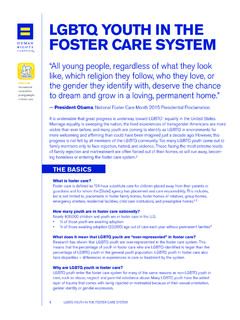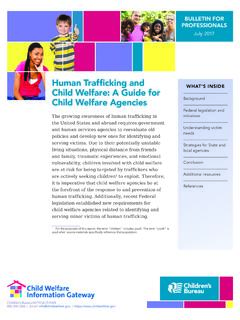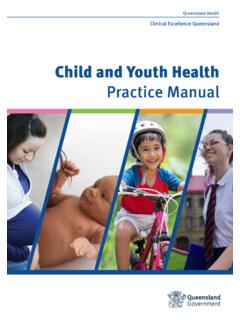Transcription of Impact of the COVID-19 Pandemic on Children Youth and …
1 Impact of the COVID-19 Pandemic 1 Impact of the COVID-19 Pandemicon Children , Youth and FamiliesIMPROVING CARE. CHANGING 2020 | Issue BriefWritten by: Jacqueline ShenEditors: Matthew Pecoraro, MSW and Christopher Bellonci, MDSPOTLIGHT ONA brief produced by the Evidence-Based Policy Institute2 Judge Baker Children s Center Issue Brief2 Judge Baker Children s Center Issue BriefTable of ContentsIntroduction | 3 4 Micro-Level Factors | 5 7 Meso-Level Factors | 7 8 Macro-Level Factors | 8 10 Conclusion and Implications | 11 12 Recommendations for Policy, Systems.
2 And Practice Development | 11 12 Resources | 13 15 Transgender & Gender-Nonconforming | TNGC Youth in Massachusetts 3 Impact of the COVID-19 Pandemic 3 Impact of the COVID-19 Pandemic 3 On March 10th, 2020, the COVID-19 Pandemic was declared a state of emergency in Within the next two weeks, schools and child care programs were closed, and a stay-at-home advisory was In the months that followed, the need for social distancing meant Youth ages 5-18 were kept at home and away from their peers, unable to attend school for in-person K-12 education. The full Impact of quarantine, social isolation, and the Pandemic on Youth mental health remains to be seen.
3 However, preliminary research and anecdotal observations suggest that there is a coming tidal wave of behavioral health needs among Youth , especially Youth from vulnerable and historically marginalized communities. Though there is not yet extensive literature on this recent and ongoing crisis, available research and experiences from previous pandemics can inform our next steps as we seek to identify and respond to the needs of Youth in the coming months and years. Even without the Pandemic , a significant number of Youth experience mental health challenges. Research shows one in five Youth experience a diagnosable behavioral health concern, and half of all mental health issues begin by age For Youth experiencing a mental health concern, early identification and intervention may be critical to improved health and Given that the Pandemic will almost certainly exacerbate Youth mental health needs, now is the time to consider how those needs will be met.
4 As Massachusetts schools welcome students back, governments, school systems, and communities have an opportunity to consider how we can best provide resources to support our Children through this tumultuous time both now and into the Office of Governor Charlie Baker and Lt. Governor Karyn Polito, Office of Governor Charlie Baker and Lt. Governor Karyn Polito, Takkunen & Zlevor, 20184 Takkunen & Zlevor, 20184 Judge Baker Children s Center Issue Brief4 Judge Baker Children s Center Issue BriefWho are the Youth Impacted by COVID-19 ?In Massachusetts, roughly 14% of the population is between ages 5 and 18, amounting to nearly one million youths residing in the In 2019, approximately 92% of these youths were enrolled in K-12 programs, and consisted of a diverse racial and ethnic representation, as shown in the table Prior to the Pandemic , about 12% of Children ages 18 and under lived in households with incomes below the federal poverty level, and about 20% lived in households receiving supplemental security income (SSI, cash public assistance, or food stamp/SNAP benefits).
5 7 Enrollment by Race/Ethinicity (2019-2020)Race% of StateAfrican , Non-Hispanic American Hawaiian, Pacific : Massachusetts Department of Elementary and Secondary Conditions in the Home and Community Environment Contribute to Negative Mental Health Outcomes for Youth During the COVID-19 Pandemic ? This report explores potential impacts of the Pandemic on Youth mental health in Massachusetts, highlighting issues for which there is preliminary supporting data, as well as issues that have arisen out of prior pandemics. The issues listed below are not meant as a comprehensive list, but rather a starting point as we begin the long process of supporting the Commonwealth s Children and families during and after COVID-19 .
6 This report draws on Bronfenbrenner s ecological systems theory,9 beginning first with a child s immediate surroundings and expanding to the larger environment: factors that may arise in a Youth s family and home life; factors that result from changes to broader systems and structures Youth interact with such as schools and healthcare; factors that indirectly Impact Youth and families , but permeate our communal beliefs, values and culture, and drive social United States Census Bureau, 6 Department of Elementary and Secondary Education, United States Census Bureau, Department of Elementary and Secondary Education, Bronfenbrenner, 1979 Transgender & Gender-Nonconforming | TNGC Youth in Massachusetts 5 Impact of the COVID-19 Pandemic 5 Impact of the COVID-19 Pandemic 5 MICROMESOMACROQ uarantine Quarantine can have lasting negative impacts on Youth mental health.
7 In the short term, mandatory confinement can bring about irritability, anger, confusion, frustration, loneliness, denial, and In the long term, forced quarantine has been shown to produce post-traumatic stress disorder (PTSD) in Children with pre-existing mental health conditions are especially at risk for developing these symptoms and pandemics have demonstrated that quarantine can create the need for additional mental health services for Youth . A study examining the effects of social isolation during the H1N1, SARS, and avian flu pandemics in the , Mexico, and Canada revealed that Children who hadexperienced quarantine were five times more likely torequire mental health services related to the pandemicand experienced higher levels of post-traumatic of Children who had been subject to diseasecontainment measures needed mental health services dueto Pandemic -related experiences.
8 For Children whoaccessed services, the most common diagnoses weregeneralized anxiety disorder and adjustment IsolationWhile in quarantine, Youth are largely isolated from their peers a particularly problematic situation since Youth rely heavily on peer interaction for identity formation and Peer support at this developmental stage is crucial, and social isolation is associated with an increased risk for depression and anxiety (with duration of loneliness as the factor most strongly associated with anxiety). Isolation has also been linked with suicidal ideation, self-harm, and eating disorder risk Notably, social isolation may have long-term effects on mental health and has been associated with mental health problems up to nine years Factors: Family & Home LifeSection 1:Child Abuse & NeglectIn quarantine, Children also face an increased risk of domestic violence and abuse.
9 Existing tensions within members of the household are more likely to be escalated and new stressors are likely to arise, potentially elevating dangerous One such stressor is increased exposure to overcrowding a stressor that disproportionately affects Youth living in Another major stressor for many families is financial insecurity. From March to May of 2020, the unemployment rate in Massachusetts rose from to The mental burden of unstable or inadequate financial support can result in poor adult mental health, which can then translate into secondary stress for Youth and risk for child Any traumatic events that follow, such as abuse or violence, can adversely affect a child s development in areas such as emotion regulation, attention, memory, and response has also meant that reporting child abuse and neglect has become more difficult.
10 Teachers, who have historically been the primary source of child abuse reports during school hours, are less able to monitor students for warning signs due to school closures. Accordingly, reports of child abuse and neglect in Massachusetts initially dropped by 60%.22 While reporting numbers have increased slightly, anecdotal stakeholder testimony suggests decreased visibility of Children at risk remains an issue. 2310 Jiao et al., 2020 11 Dubey et al., 202012 Dubey et al., 202013 Sprang & Silman, 201314 Loades et al., 202015 Loades et al., 202016 Loades et al., 202017 Storz, 202018 Holmes et al.





